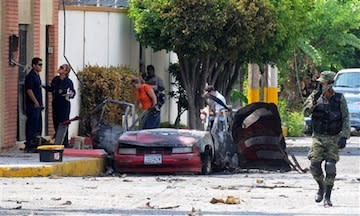 The Upshot
The UpshotWhat can Mexico learn from Colombia’s drug war?

In the space of a week, the powerful drug cartel Los Zetas has been suspected of launching a full-on attack on social institutions in the northern Mexican state of Tamaulipas, hitting the media, police, an elected official and the court system in what appears to be an effort to prevent the investigation of a massacre of migrants.
Early last week, 72 migrants were kidnapped and massacred in what the lone survivor said was an act of retaliation for their refusal to join the gang. Then, the lead investigator sent to probe the crime mysteriously disappeared and has not been heard from since. On Thursday, two car bombs exploded: one outside the local TV news station's offices, knocking out the facility's signal; the other outside the local police station.
Then on Sunday, the mayor of Hidalgo, a town close to the site of the massacre, was assassinated in front of his 10-year-old daughter, who was hurt in the attack.
This assault on the rule of law, coupled with escalating displays of violence like car bombs and machine-gun massacres, brings to mind gang-ridden Colombia in the 1980s. During the heyday of that nation's cocaine empires, even presidential candidates were assassinated for crossing the powerful Cali and Medellín cartels. Indeed, experts on the Mexican drug trade have cited the Colombian experience as an ominous parallel as they've watched the country's many cartels grow in influence. Since 2006, an estimated 28,000 people have died in Mexico's drug wars.
To defeat the cartels in Colombia, the government employed a kingpin strategy: going after high-value traffickers and extraditing them to the United States for trial.
Mexico so far appears to be following the same enforcement model. Just Monday, Mexican authorities captured Edgar Valdez Villarreal, a U.S. citizen known as "La Barbie" for his light complexion. Valdez was a top player in the Beltran Leyva Cartel. (The cartel's former head was killed by Mexican marines in December.)
But experts are divided over whether this strategy will be as effective in Mexico as it was in Colombia.
Vanda Felbab-Brown, a fellow at the Brookings Institution, tells The Upshot that in the short term, at least, arresting the head of a cartel can cause even more violence. Succession wars will break out in the face of a power vacuum, she says, with other groups emerging to challenge the weakened gang. To prevent "turf wars," authorities need to conduct stings that lead to the arrest of dozens of members of the organization, not just the head, she argues.
The comparison to Colombia is too "simplified," she contends, because in Colombia authorities were only battling two major cartels. By pitting them against each another, law enforcement was eventually able to bring about their destruction. In Mexico, the greater number of cartels makes succession and rivalries more complicated and difficult to manipulate.
But Adam Isacson, a senior associate at the Washington Office on Latin America, says the tactic is an improvement on the "shock and awe" tactics President Felipe Calderon had previously employed in battling the cartels.
"It certainly makes more sense to go after the capos [gang leaders] then it does to just send the army out on the streets to fight them house to house," Isacson said. "It takes a lot of intelligence work, it takes a lot of police work. Even in the case of La Barbie, the police say they started this case in June of 2009."
Former Drug Enforcement Agency Administrator Robert Bonner writes in Foreign Affairs that "virtually all the key lessons learned from the defeat of the Colombian cartels in the 1990s are applicable to the current battle against the Mexican cartels."
But Mexico faces some unique challenges. Though the Colombian cartels were more powerful than the network of gangs in Mexico today, Colombia also benefited from a stronger democratic tradition than Mexico, Bonner argues. Colombia's powerful central government also made it easier for officials to reform the police system; the fragmented republic of Mexico, meanwhile, has resisted even the most elementary efforts to increase order and accountability. Mexico uses a patchwork system of "two federal, 32 state, and over 1,500 municipal police agencies," to police drug offenses, Bonner writes.
Recently, Mexico's federal police force has started taking more serious steps to root out corruption in its ranks, firing 10 percent of its force just this year for suspected corruption.
Bonner wrote in an email that the massacre of the migrants shows that "the depravity of these organized criminals knows no limits." He added: "The era of impunity must end."
Felbab-Brown said the disappearance of the prosecutor in Tamaulipas is especially troubling. In Colombia, she notes, drug traffickers assassinated hundreds of judges. "The narcos completely decimated the justice system in Colombia," she said.
"I think it's really showing the intensity of the violence and the ambition on the part of the narcos to really intimidate society and to also show the state that they are very fierce challenge to them."
Meanwhile, Phil Jordan, former director of the anti-drug El Paso Intelligence Center, told the El Paso Times that the violence will just get worse.
"The grenades, the car bombings in Mexico is just a preview of the worse to come. The collateral damage is nothing now in what can happen to the future," Jordan said. "These people will only react to General Patton-type force."
(Photo of the remnants of a car bomb detonated outside a local TV station in Tamaulipas: AP)
